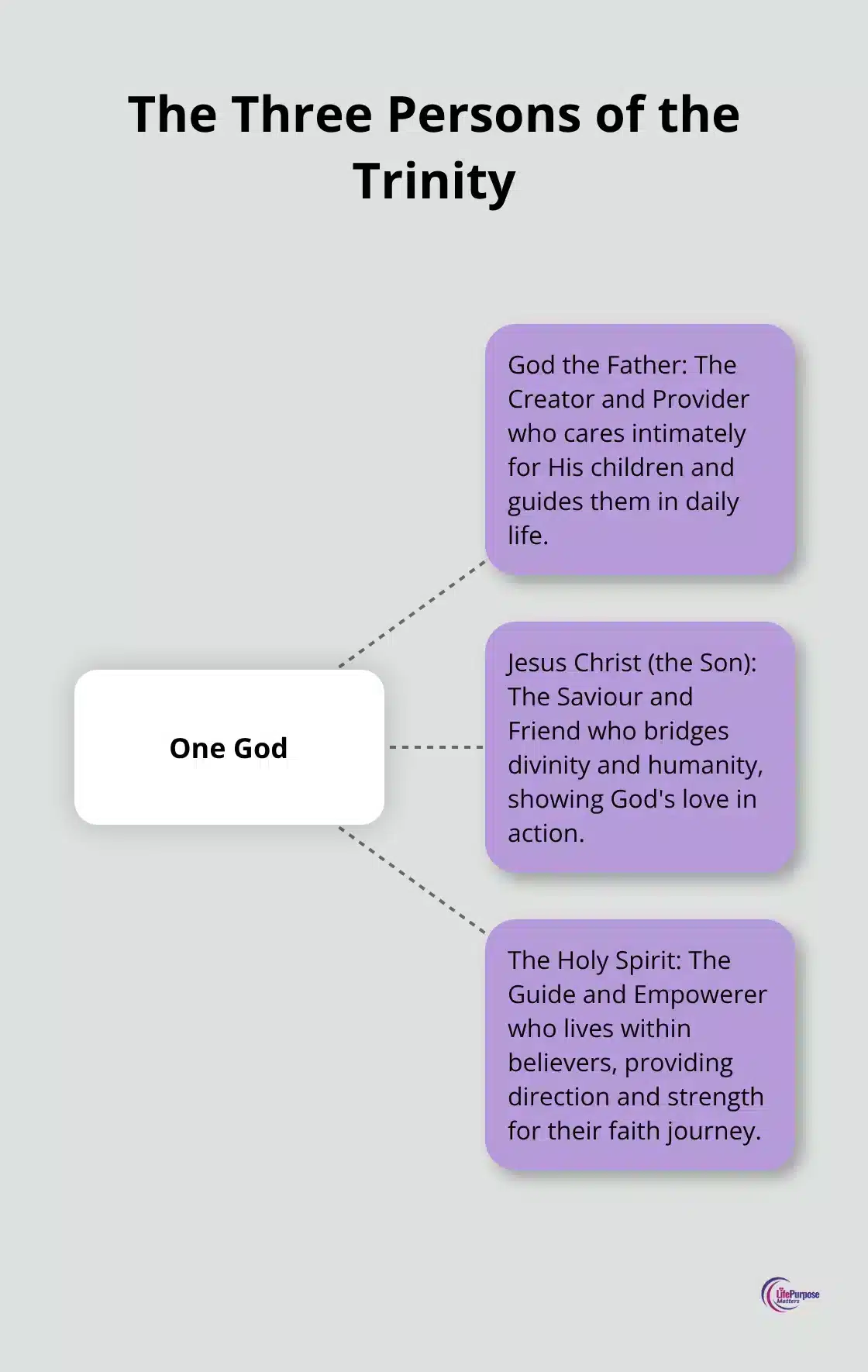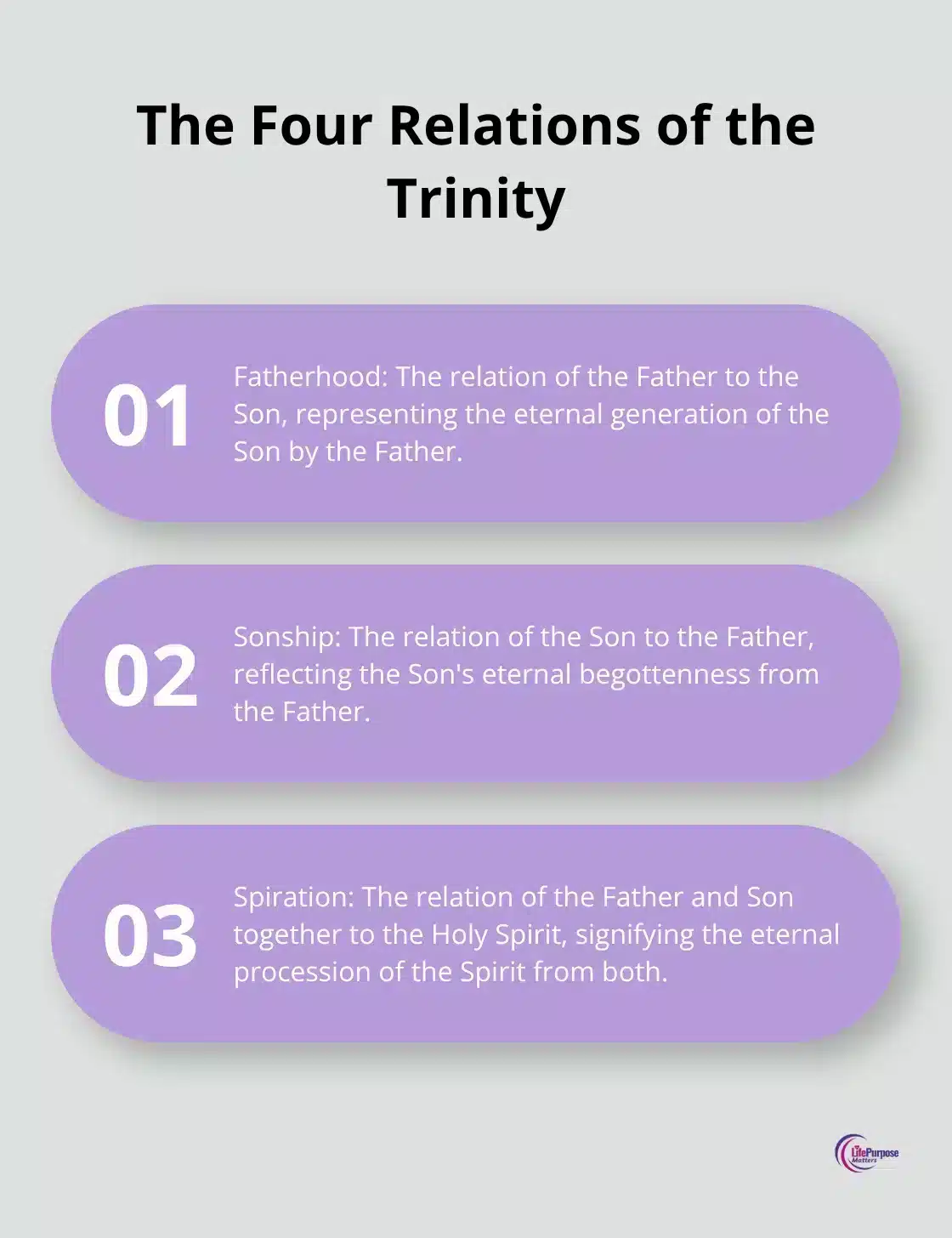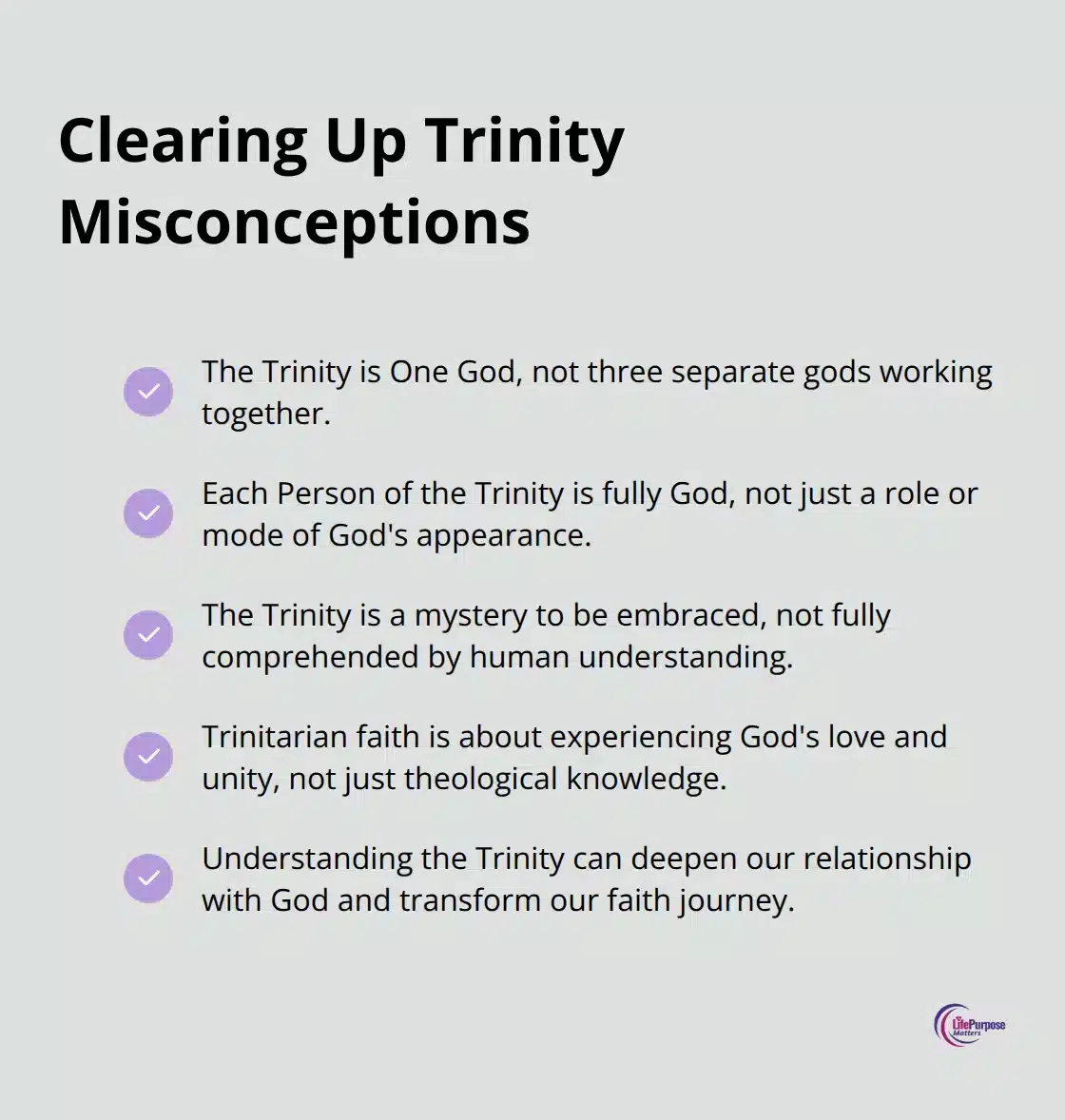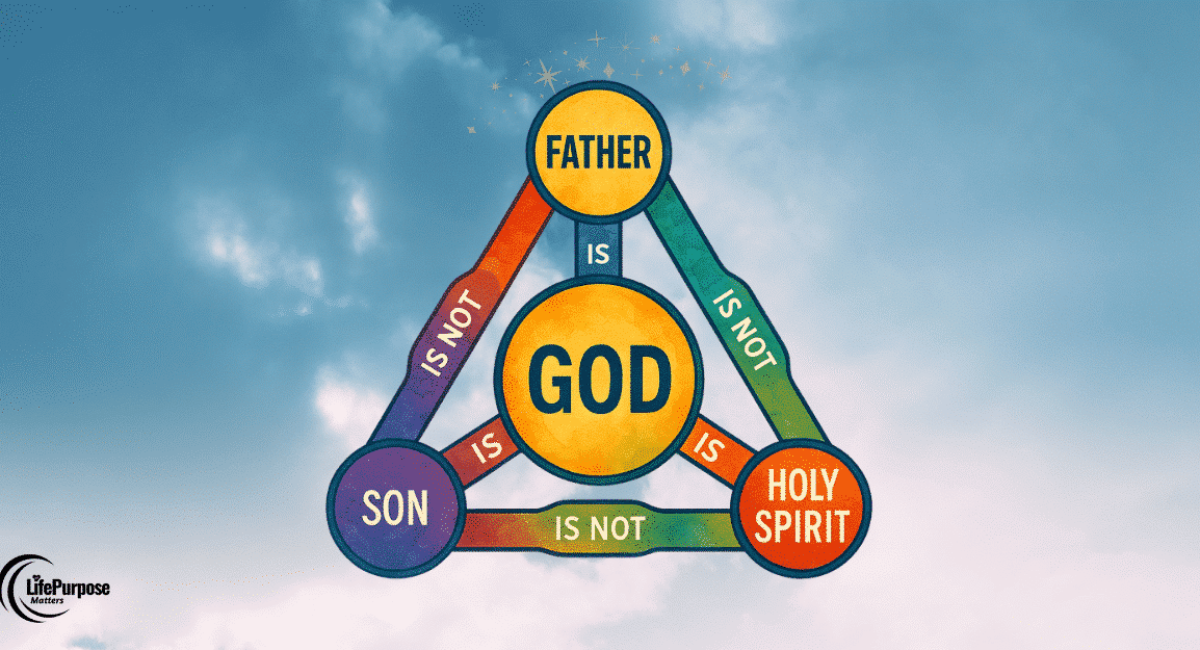Have you ever wondered, “What is the Trinity?” The concept of the Trinity stands as one of the most profound and, at times, perplexing doctrines within Christianity, and is often misunderstood. At its core, it’s the belief that there is one God who eternally exists as three distinct persons: the Father, the Son (Jesus Christ), and the Holy Spirit. This isn’t a simple equation of three gods; rather, it’s a theological mystery of one God in three persons. For centuries, theologians, scholars, and everyday believers have grappled with this idea, asking, “How can one God be three? At Life Purpose Matters, we believe that grasping this profound truth can transform your spiritual journey. This article will demystify the core components of the Godhead, exploring the biblical foundations and historical context that have shaped our understanding of this central Christian truth. Let’s explore the mystery of the Godhead together and discover how it impacts our daily walk with God.
Table of Contents
ToggleWhat Is the Trinity?
The Core Concept
Have you ever scratched your head over the Trinity? You’re not alone! At its heart, the Trinity is the Christian belief that God exists as one Being in three Persons: the Father, Son (Jesus Christ), and Holy Spirit. It’s a doctrine that’s both beautifully simple and mind-bendingly complex.
Biblical Foundations
You might wonder, “Where does this idea come from?” While the word “Trinity” doesn’t appear in the Bible, the concept threads through Scripture. In Genesis 1:26 (NLT), God uses plural pronouns: “Let us make human beings in our image, to be like us.” Fast forward to the New Testament, and we witness all three Persons of the Trinity at Jesus’ baptism (Matthew 3:16-17). The Father speaks from heaven, the Son receives baptism, and the Holy Spirit descends like a dove. 💜
Historical Development
The early Church didn’t just wake up one day with a fully formed doctrine of the Trinity. This understanding evolved as believers wrestled with Scripture and their experiences of God. The doctrine of the Trinity was first formulated among the early Christians in the mid-2nd century and later, as they attempted to understand and articulate their experiences of God.
Living Trinitarian Faith
So what does this mean for us today? Understanding the Trinity isn’t just about correct theology – it’s about experiencing the fullness of God’s love and community. The Trinity reveals that one nature in God exists, with two processions, three persons, and four relations that constitute the Blessed Trinity.

Practical Impact
Many of us at Life Purpose Matters have seen how embracing this truth can transform lives. It’s not about having all the answers (who does?), but about opening ourselves to the mystery and wonder of God’s nature. As we do this, we often find our own relationships deepen and our sense of purpose grows.
The Trinity isn’t just a theological concept – it’s an invitation to experience God in all His fullness. As we explore the distinct roles of the Father, Son, and Holy Spirit, we’ll uncover how each Person of the Trinity uniquely relates to us and shapes our faith journey.
Who Are the Three Persons of the Trinity?
The Trinity is more than a theological concept; it’s a living reality that shapes our faith journey. Let’s explore how each Person of the Trinity uniquely impacts our lives and deepens our relationship with God.
God the Father: Our Creator and Provider
When we think of God the Father, we often picture a distant, authoritative figure. But nothing could be further from the truth! The Father involves Himself intimately in our lives, caring for us as His beloved children. He’s not just the Creator of the universe; He’s the one who knows the number of hairs on your head (Luke 12:7).
How does this change our daily lives? It means we can approach Him with confidence, knowing He cares about every detail of our existence. When you face a tough decision at work or struggle with a personal issue, remember that you have a Father who’s eager to guide you. Try to start each day by acknowledging His presence and asking for His wisdom in all you do.
Jesus Christ: Our Saviour and Friend
Jesus, the Son, bridges the gap between humanity and divinity. He’s not just a historical figure or a set of teachings; He’s a living Saviour who wants to walk alongside us every day. Through His life, death, and resurrection, Jesus shows us what God’s love looks like in action.
But how do we connect with Jesus in our everyday lives? It’s simpler than you might think. Start by reading the Gospels, not just as historical documents, but as personal letters to you. When you face challenges, ask yourself, “What would Jesus do?” And don’t just wonder – act on it! Serve others, show compassion, and stand for justice (these are all ways we can embody Christ’s love in our world).
The Holy Spirit: Our Guide and Empowerer
The Holy Spirit is often the most misunderstood Person of the Trinity, but He’s essential to our Christian walk. He’s not an impersonal force; He’s God’s presence living in us, guiding us, and empowering us to live out our faith.
How can we experience the Holy Spirit’s power in our lives? It starts with being open to His leading. Pay attention to those inner promptings – they might be the Spirit guiding you. When you feel weak or inadequate, remember that the same power that raised Jesus from the dead lives in you (Romans 8:11). Pray for the Spirit’s guidance in your decisions, big and small. You might surprise yourself at how He works through you when you’re willing to listen and obey.

Embracing the Trinity in Daily Life
Understanding the Trinity isn’t just about getting our theology right. It’s about experiencing the fullness of God’s love, guidance, and power in our lives. As we engage with each Person of the Trinity, we open ourselves to a richer, more vibrant faith journey.
Now that we’ve explored the distinct roles of the Father, Son, and Holy Spirit, you might wonder how this knowledge impacts your everyday faith. Let’s address some common misconceptions about the Trinity and see how a clearer understanding can transform your spiritual walk.
Unravelling Trinity Misconceptions
When it comes to understanding the Trinity, it’s easy to get tangled up in misconceptions. Let’s clear the air and explore some common misunderstandings that might hold you back from fully embracing this profound aspect of our faith.
Not Three Gods in a Trench Coat
One of the biggest misconceptions about the Trinity is that we’re talking about three separate gods working together. This couldn’t be further from the truth! The Trinity means that there is one God who eternally exists as three distinct Persons – the Father, Son, and Holy Spirit. It’s not a divine committee or a celestial tag team. When we pray, we don’t choose which ‘version’ of God to address. We connect with the one true God in His fullness.
Beyond Cosmic Costume Changes
Another misunderstanding views the Trinity as God simply changing hats or roles. This idea, known as modalism, suggests that God appears as the Father, then the Son, then the Holy Spirit, like an actor changing costumes. But the Trinity isn’t about God shape-shifting. Each person of the Trinity is fully God, all the time, working in perfect harmony.
Embracing the Mystery
Let’s be honest – explaining the Trinity can feel like trying to nail jelly to a wall. It’s complex, and that’s okay! The challenge isn’t to fully comprehend it (we’re dealing with an infinite God, after all), but to embrace its truth and let it transform our faith.
Instead of getting bogged down in theological gymnastics, try to experience the Trinity in your daily life. Thank the Father for His love and provision when you pray. Meditate on Jesus’ teachings and actions, allowing them to shape your choices. Be open to the Holy Spirit’s guidance, listening for that still, small voice in your heart.

Living Trinitarian Faith
The goal isn’t to have all the answers, but to grow in relationship with our triune God. As you do this, you’ll likely find your faith deepens and your understanding of God’s love expands in ways you never imagined.
Try to focus on the practical aspects of Trinitarian faith. Reflect on how each person of the Trinity (Father, Son, and Holy Spirit) impacts your life differently. This approach can lead to a richer, more nuanced understanding of God’s nature and His work in your life.
Final Thoughts
The doctrine of the Trinity is not merely an abstract theological puzzle; it’s the very foundation of how Christians understand God’s nature and their relationship with Him. It reveals a God who is not a solitary figure but a community of loving persons in perfect relationship. The Father is the Creator and source of all things, the Son is the Redeemer who bridged the gap between God and humanity, and the Holy Spirit is the Comforter and Sanctifier who empowers believers to live a godly life. Ultimately, understanding the Trinity is not about having all the answers but about drawing closer to the God who is a perfect, loving fellowship, inviting us into His eternal community. We can approach the Father with confidence, follow Jesus as a living Saviour, and rely on the Holy Spirit’s constant presence and power.
Understanding “What is the Trinity?” doesn’t require a theology degree. It starts with simple practices: addressing each Person of the Trinity in prayer, reflecting on their unique relationships with us, and mirroring their unity in our own relationships. These practices can transform our spiritual journey and deepen our connection with God.
At Life Purpose Matters, we believe that grasping the Trinity is key to discovering your God-given purpose. Let this truth inspire you to seek God more earnestly and live out His love more fully in the world around you (after all, we are created in the image of a triune God). Embrace the Trinity, and watch how it revolutionises your faith walk.

